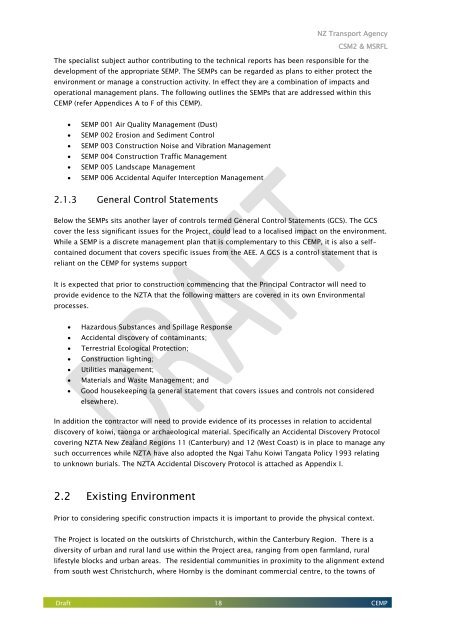CEMP - NZ Transport Agency
CEMP - NZ Transport Agency
CEMP - NZ Transport Agency
You also want an ePaper? Increase the reach of your titles
YUMPU automatically turns print PDFs into web optimized ePapers that Google loves.
<strong>NZ</strong> <strong>Transport</strong> <strong>Agency</strong><br />
CSM2 & MSRFL<br />
The specialist subject author contributing to the technical reports has been responsible for the<br />
development of the appropriate SEMP. The SEMPs can be regarded as plans to either protect the<br />
environment or manage a construction activity. In effect they are a combination of impacts and<br />
operational management plans. The following outlines the SEMPs that are addressed within this<br />
<strong>CEMP</strong> (refer Appendices A to F of this <strong>CEMP</strong>).<br />
• SEMP 001 Air Quality Management (Dust)<br />
• SEMP 002 Erosion and Sediment Control<br />
• SEMP 003 Construction Noise and Vibration Management<br />
• SEMP 004 Construction Traffic Management<br />
• SEMP 005 Landscape Management<br />
• SEMP 006 Accidental Aquifer Interception Management<br />
2.1.3 General Control Statements<br />
Below the SEMPs sits another layer of controls termed General Control Statements (GCS). The GCS<br />
cover the less significant issues for the Project, could lead to a localised impact on the environment.<br />
While a SEMP is a discrete management plan that is complementary to this <strong>CEMP</strong>, it is also a selfcontained<br />
document that covers specific issues from the AEE. A GCS is a control statement that is<br />
reliant on the <strong>CEMP</strong> for systems support<br />
It is expected that prior to construction commencing that the Principal Contractor will need to<br />
provide evidence to the <strong>NZ</strong>TA that the following matters are covered in its own Environmental<br />
processes.<br />
• Hazardous Substances and Spillage Response<br />
• Accidental discovery of contaminants;<br />
• Terrestrial Ecological Protection;<br />
• Construction lighting;<br />
• Utilities management;<br />
• Materials and Waste Management; and<br />
• Good housekeeping (a general statement that covers issues and controls not considered<br />
elsewhere).<br />
In addition the contractor will need to provide evidence of its processes in relation to accidental<br />
discovery of koiwi, taonga or archaeological material. Specifically an Accidental Discovery Protocol<br />
covering <strong>NZ</strong>TA New Zealand Regions 11 (Canterbury) and 12 (West Coast) is in place to manage any<br />
such occurrences while <strong>NZ</strong>TA have also adopted the Ngai Tahu Koiwi Tangata Policy 1993 relating<br />
to unknown burials. The <strong>NZ</strong>TA Accidental Discovery Protocol is attached as Appendix I.<br />
2.2 Existing Environment<br />
Prior to considering specific construction impacts it is important to provide the physical context.<br />
The Project is located on the outskirts of Christchurch, within the Canterbury Region. There is a<br />
diversity of urban and rural land use within the Project area, ranging from open farmland, rural<br />
lifestyle blocks and urban areas. The residential communities in proximity to the alignment extend<br />
from south west Christchurch, where Hornby is the dominant commercial centre, to the towns of<br />
Draft 18 <strong>CEMP</strong>
















